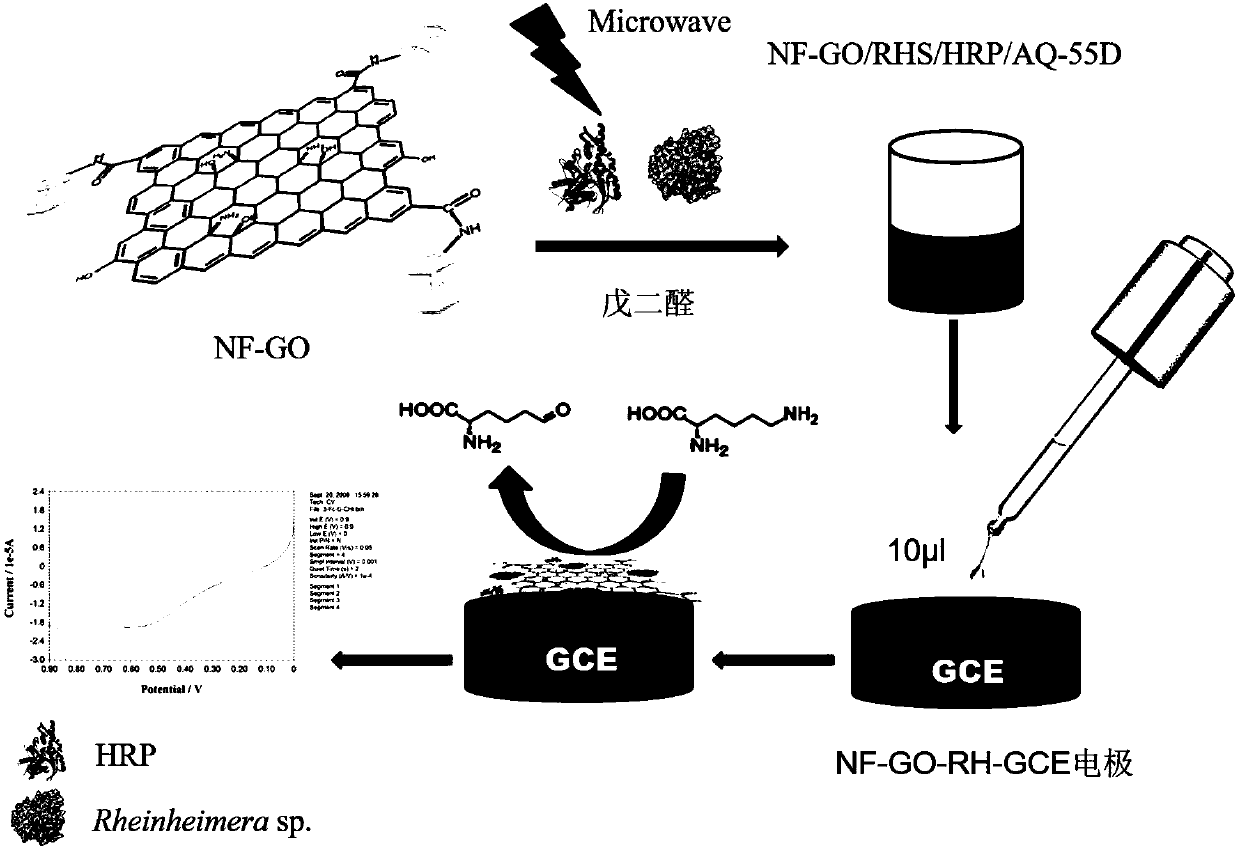Electrochemical L-lysine sensor based on graphene material and preparation method thereof
A technology of lysine oxidase and graphene is applied in the field of L-lysine electrochemical sensor and its preparation, which can solve the problems of no electrochemical activity, complicated analysis process, long detection time, etc., and achieves accelerated direct electron transfer. , large specific surface area, good electrical conductivity
- Summary
- Abstract
- Description
- Claims
- Application Information
AI Technical Summary
Problems solved by technology
Method used
Image
Examples
Embodiment 1
[0030] see figure 1 , which is a schematic flow chart of preparing a graphene-based L-lysine electrochemical sensor in this embodiment.
[0031] In this example, the L-lysine oxidase produced by Rheinheimera sp. is used to modify the working electrode, and the amino-modified ferrocene / graphene oxide nanocomposite is used as the sensitizing material to construct a graphene-based material through a three-electrode system. L-lysine electrochemical sensor.
[0032] The preparation method of the L-lysine electrochemical sensor based on graphene material specifically comprises the following steps:
[0033] (1) Using 20mg of graphene oxide and 50mg of aminated ferrocene as raw materials, through the coupling of 19.2mg of EDC and 11.5mg of NHS, through the steps of ammonolysis, hydrazine hydrate reduction, washing, and vacuum drying, the amino-modified ferrocene was prepared. Iron / graphene oxide nanocomposite (labeled NF-GO). Next, the NF-GO composite material was dispersed in a DM...
Embodiment 2
[0046] In this example, the L-lysine oxidase extracted from Mucus of Scomber japonicus is used to modify the working electrode, and the indium trioxide / graphene nanocomposite is used as the sensitizing material to construct a graphene-based L - Lysine electrochemical sensor.
[0047] The preparation method of the L-lysine electrochemical sensor based on graphene material specifically comprises the following steps:
[0048] (1) 20mg graphene oxide, 70mg indium acetylacetonate, 150mg sodium hydroxide are added to 10ml volume ratio and be the ethanol of 1:0.8:1:0.4: water: cyclohexane: in the mixed solvent of oleic acid, then in React at 200°C for 20 hours to prepare indium hydroxide / graphene nanocomposite material, then calcinate indium hydroxide / graphene nanocomposite material at high temperature to obtain diindium trioxide / graphene nanocomposite material (marked as IO-GR) . Next, take the IO-GR composite material and disperse it in a DMF solvent, and disperse it ultrasonical...
Embodiment 3
[0060] In this example, the L-lysine oxidase produced by Trichoderma viride is used to modify the working electrode, and the fluorine-substituted graphene nanomaterial is used as the sensitizing material, and the graphene-based L-lysine electrochemical reaction is constructed through a three-electrode system. sensor.
[0061] The preparation method of the L-lysine electrochemical sensor based on graphene material specifically comprises the following steps:
[0062](1) Using fluorinated graphite with a substitution ratio of 0.25 as raw material, fluorinated graphene oxide was prepared by the improved Hummers method, and then prepared by reduction with sodium borohydride and hydrazine hydrate to obtain fluorine-substituted graphene nanomaterials (marked as F 0.25 -GR). Next, take F 0.25 - The GR composite was dispersed in DMF solvent and ultrasonically dispersed for 20 minutes to make F at a concentration of 1 mg / ml 0.25 The DMF solution of -GR is ready for use.
[0063] (2)...
PUM
 Login to View More
Login to View More Abstract
Description
Claims
Application Information
 Login to View More
Login to View More - R&D Engineer
- R&D Manager
- IP Professional
- Industry Leading Data Capabilities
- Powerful AI technology
- Patent DNA Extraction
Browse by: Latest US Patents, China's latest patents, Technical Efficacy Thesaurus, Application Domain, Technology Topic, Popular Technical Reports.
© 2024 PatSnap. All rights reserved.Legal|Privacy policy|Modern Slavery Act Transparency Statement|Sitemap|About US| Contact US: help@patsnap.com








